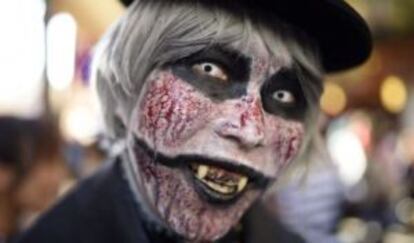How Halloween came to push out All Hallows’ Eve
Dismissed by many Spaniards as too American, the celebration’s roots lie firmly in old Europe


In Spain, Halloween continues to make inroads despite irritation from the Catholic Church and some sectors of society, who view it as too commercial and American. This year, a Cádiz church official called it “a satanic celebration that features monsters.”
All of Spain’s major festivities are both seasonal and pagan in origin – even though most of them have been passed down via Rome – and have undergone a huge commercial re-purposing in modern times.
Old traditions were adapted to local realities in the Americas – the turnip was swapped for a pumpkin, for example, as it was easier to find
Christmas is the clearest example. As Richard Cohen, author of Chasing the Sun: The Epic Story of the Star That Gives Us Life, wrote in an eloquent article about the winter solstice in The New York Times, “virtually all cultures have their own way of acknowledging this moment.”
The longest night of the year, which paves the way for increasingly long days, is a clear victory of the sun over the forces of darkness. The Romans called it Saturnalia, we call it Christmas.
Scare campaign
In Valencia, authorities are expecting Halloween celebrations to take the form of large outdoor drinking binges by groups youths, a practice known as a botellón (literally, big bottle).
On the night of October 31, the city will be sending out 160 local police officers to prevent such events from taking place in downtown squares and the City of Arts and Sciences complex.
Valencian officials are also due to launch an awareness campaign called "Pásalo de miedo y no llegues a casa hecho un zombi" (or, Have a frightfully good time but don't go home looking like a zombie).
Something similar can be said of All Hallows’ Eve, better known as Halloween in the English-speaking world.
Samhain was an old Celtic tradition held on the night of October 31 to observe the end of harvest season and the beginning of the long winter in the northern regions. A fascinating exhibition now on at the British Museum in London shows that there is no clear, unequivocal definition of Celtic culture, and that it would be more accurate to talk about artistic artifacts associated with various peoples in northern Europe.
When Rome – which also had its own celebrations to mark the end of the harvest season – came into contact with these people, it adopted their customs.
Like so many other festivities, it became part of the Spanish calendar at the time Christianity became the dominant culture in the West and pagan celebrations slowly began adapting to the new world order. The date was called All Saints’ Day or All Hallows, and was dedicated to all those martyrs who lack a specific day on the calendar, and to everyone’s departed relatives as well.
The term Halloween is derived from All Hallows’ Eve, the vigil period before All Saints’ Day.

But in that diffuse Celtic world, most especially in Ireland, many old pagan traditions refused to die, such as the habit of placing a candle inside a turnip to keep spirits at bay. The potato famine pushed many Irish families to the United States in the 19th century, and those old traditions were adapted to local realities – the turnip was swapped for a pumpkin, for example, as it was much easier to find in the Americas.
With the advent of mass consumption in the US, the celebration became increasingly popular and represented millions of dollars in sales of costumes and candy, two elements derived from the Celtic customs of wearing a mask to scare away devils and supplying them with small treats to keep them entertained.
From the 1970s onwards, Hollywood did the rest, transforming Halloween into a universal celebration through classics such as John Carpenter’s 1978 horror movie Halloween and, most particularly, Steven Spielberg’s delightful depiction of the festival in E.T. (1982).
Like Roger Clarke, author of Ghosts: A Natural History, once wrote, “ghost literature has been England’s great gift to the world.” Halloween forms part of that irresistible old tale.
English version by Susana Urra.
Tu suscripción se está usando en otro dispositivo
¿Quieres añadir otro usuario a tu suscripción?
Si continúas leyendo en este dispositivo, no se podrá leer en el otro.
FlechaTu suscripción se está usando en otro dispositivo y solo puedes acceder a EL PAÍS desde un dispositivo a la vez.
Si quieres compartir tu cuenta, cambia tu suscripción a la modalidad Premium, así podrás añadir otro usuario. Cada uno accederá con su propia cuenta de email, lo que os permitirá personalizar vuestra experiencia en EL PAÍS.
¿Tienes una suscripción de empresa? Accede aquí para contratar más cuentas.
En el caso de no saber quién está usando tu cuenta, te recomendamos cambiar tu contraseña aquí.
Si decides continuar compartiendo tu cuenta, este mensaje se mostrará en tu dispositivo y en el de la otra persona que está usando tu cuenta de forma indefinida, afectando a tu experiencia de lectura. Puedes consultar aquí los términos y condiciones de la suscripción digital.
Archived In
Últimas noticias
Most viewed
- Pablo Escobar’s hippos: A serious environmental problem, 40 years on
- Reinhard Genzel, Nobel laureate in physics: ‘One-minute videos will never give you the truth’
- Why we lost the habit of sleeping in two segments and how that changed our sense of time
- Charles Dubouloz, mountaineering star, retires at 36 with a farewell tour inspired by Walter Bonatti
- The Florida Keys tourist paradise is besieged by immigration agents: ‘We’ve never seen anything like this’








































